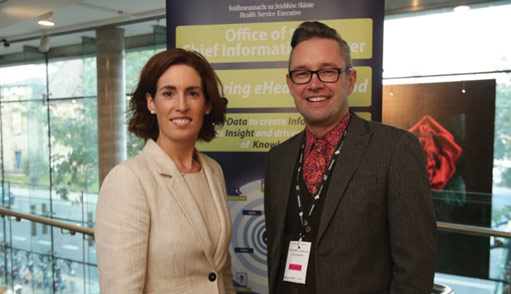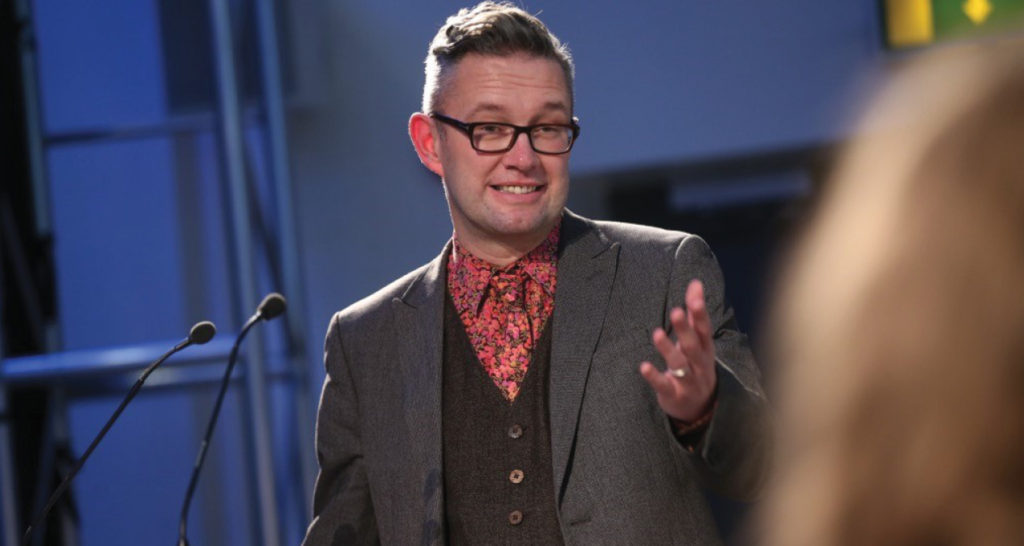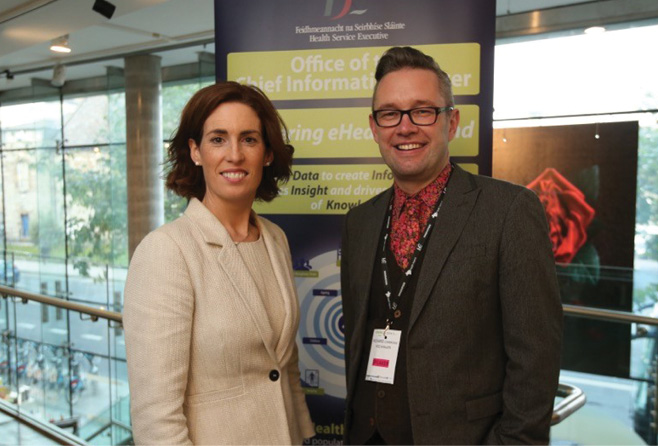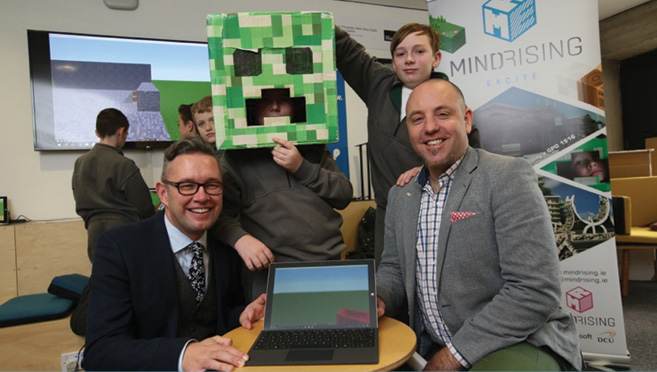Innovating to improve


Ahead of Health Innovation Week, eolas meets with HSE Chief Information Officer Richard Corbridge to explore the potential for the future of healthcare in Ireland.
“Health Innovation Week [21-27 November] initially started out as only a single day. At the start we decided we would bring together innovators from across Ireland and demonstrate to the public, to politicians, to clinicians and, to other health informatics people what innovation could mean in health. Instead of merely looking at 2020, we wanted to look at what healthcare could look like in 2030,” outlines Richard Corbridge.
“As we started to plan and people got enthused and excited, it turned into two days. We filled those with people from across the world. We got people coming from the NHS. For example, the Chief Information Officer, the Director of NHS Digital and the Chief Clinical Information Officer. We also have people coming from all across Ireland with different innovative ideas. We have Oxford professor Gina Neff, talking on wearables and Quantified Self [life logging]. The Health Minister [Simon Harris] is opening one day; the Chief Scientific Adviser to the Government [Mark Ferguson] is opening another.
“These two days have grown into a showcase of what innovation is. Firstly, by showing actual product and showing new things such as genomics, augmented reality, virtual reality, artificial intelligence and all the far-reaching changes in technology that could happen. Secondly, by bringing people together. At least 15 schools are coming, not just to see the new technology, but also to engage in what healthcare could look like in 2030. It’s a phenomenal opportunity to engage kids so that when they see the healthcare system changing as they grow up, they will recognise that they were involved in some of those conversations.”
On top of this, eHealth Ireland were invited to take part in Internet of Things World Europe and to lead a whole healthcare section. Corbridge explains: “What we’ve tried to say is that, instead of the Internet of Things and the traditional definition of IoT, what we’ve moved it towards is internet of the patient. We are now moving in the direction of the commercialisation of quantifying patients and people in their homes and caring for them.”
As part of Health Innovation Week, eHealth Ireland is also participating in the BiPolar Innovate Hackathon with Trinity College Dublin. This comprises over 50 clinicians and 50 technicians coming together for two days. The objective, Corbridge notes, is that “on the Saturday morning, we present to them what digital solutions could help in the care of people with bi-polar disorder and by Sunday night they will have solutions that, on Monday, we could give to a patient and say, ‘this will help you with your illness’.”
In addition to this, HIMSS, a global organisation which looks after healthcare leadership and health informatics leadership, has, for the first time, relocated their Executive Leadership Summit out of the King’s Fund in London to Dublin. “On the Thursday they are running what they call an ELS at the RDS for the day. This is 200 leaders from across the world, coming together to talk about how leadership in healthcare can be delivered in such turbulent times and how things like the election of [Donald] Trump and Brexit impact upon efforts to provide this leadership.”
Alongside this, Maria O’Loughlin, an Engagement Specialist at the HSE has arranged a series of fringe events. Maria summarises: “We’re hosting a breakfast meeting around cyber security and privacy in healthcare and a second with Trinity College looking at healthcare through the ages and how we can actually keep moving forward, powering healthcare through education. We also have a match-making event to bring clinicians and start-ups together with multinational organisations. This will be almost like a blind-date type scenario to try and match these people together in order to collaborate, learn, support and advise each other.”

Innovation practices
There are three main innovation-focused streams stemming from eHealth Ireland. Corbridge details:
“The first is eHealth Connect and on the first Tuesday of each month a team go to a different city in Ireland, promoting the fact that they will be in that city, and set up shop in order to meet any innovators or SMEs from within that community that are trying to do something in health. They’ve effectively set up a funnel that allows innovators and new companies to meet experts, be connected to clinicians, access a small amount of funding to allow pilots to happen and drive them towards the health innovation hub, which is a permanent fixture mainly run out of University College Cork.”
The second stream is called the Quality Innovation Corridor (QIC). “That’s a clinician focused initiative,” explains Corbridge. “Clinicians have amazing digital ideas and we have not, in the past, been good at supporting those ideas. There are 200 clinicians across Ireland who lead innovation, digital and technology from a clinical point of view. What we’ve done is set up a programme that actually allows clinicians to come in, suggest what their idea is, we then connect them to a digital organisation, we seed fund that idea and help the clinician take that through.”
The final stream is the recently announced Innovation Centre. “Four rooms in Temple Street Children’s University Hospital will be converted into an innovation centre. Two of those rooms will have every digital solution that the HSE has procured and put in place, with test and seed data, the connectivity out and across the interoperability.”
Corbridge condenses the objective: “Innovators, new and big companies will be able to book time in those rooms to come and test their new ideas and see how they work with things like the Individual Health Identifier, the Electronic Referral and the Healthlink. This will allow people to come and try different ways that they can work. One of the other two rooms will be used as a digital training and adoption room, while the other will be used as a permanent access point for our Chief Clinical Information Officer.”
“I think the most exciting innovation that is happening is the Cork University Maternity Hospital going live with Ireland’s first electronic health record. So on the Saturday morning the last baby will be born with a paper record and by Saturday lunchtime the first baby will be born with a digital record. Connecting a baby in an incubator to all of the devices that measure respiratory and heart rates, temperature and therefore directly into the IT system.”
Enthusiastically, Corbridge continues: “Imagine a clinician on a ward with a tablet computer in their hand with the ability to look at exactly what is happening to a baby in an incubator elsewhere in the hospital. Or, even better, imagine the mother or father being able to see what’s happening to their baby via their mobile phone whilst resting or whilst the father is back at home, or however that might work. It’s a phenomenal opportunity.”
Opportunities
There are a variety of doors which can potentially be unlocked through innovation. “Our biggest programme at the moment is the Electronic Health Record Business Case. So literally a digital solution for health records across, not just maternity or disease-specific records, but the whole of Ireland. That is a documented €850 million investment over 10 years. It’s a large amount of money to invest, but we are the last developed nation to not have an Electronic Health Record. Botswana’s EHR went live in 2016 and Ireland still does not have one. So you start to realise the necessity of moving to direction.
“Perhaps the most important thing that can happen, and we’ve already seen this, concerns genomic sequencing.
In Ireland we’ve started our first programme to sequence the genome of children under the age of five with suspected epilepsy. With additional funding you can sequence the genome of many disease areas, you can contextualise care, you can find out what’s going to happen to people before it actually happens.”
Corbridge concedes: “We talk about the health service. This is the wrong phrase, we’re a sickness service and I know people say that a lot, but perhaps more in Ireland than in other places we really do care for the sick. We aren’t good at keeping people healthy using the service to do that at this point in time and I think that digital could do that.”

Challenges
That being said, there are a number of pressing challenges facing the innovation of Irish healthcare.
“Trust is a massive issue. One of the big things in relation to the Showcase is to try using it to build trust with the public. To enable them to come and see these new solutions and talk about privacy and how we should share information and data. This can help people to understand that a robust, careful and considered team is putting this together.”
However, he emphasises: “I think the biggest challenge though, in health, is funding. We still are the smallest IT per capita in the EU and we’re the smallest public sector IT team in Ireland. We have 288 people working for us today. To drive some of the things that we have done in the last 12 months is a huge credit to a very small team. That is our biggest challenge. How do we actually move from not far off a skeleton team to a team that can really bring some of these digital solutions to Ireland at pace and at volume.”
Disruption
Digital disruption is about changing culture and about changing business practices to bring a more immediate benefit.
“The way I try to describe it is we used to have IT. Now we have innovation of IT, whereby it grows and changes. We’ve moved more towards this idea that IT is perhaps a misnomer and perhaps digital is a better term for what we’re trying to do, because, for me, digital is more about the width of the business change that happens.
“So if you’re going on a digital journey, you’re taking clinicians and people with you to change how they work and live. If you’re going on a IT journey, you’re implementing tin and wires to give people solutions. If you innovate IT, you can become digital, but if you have digital solution you disrupt and change the way people work. ‘Disruption’ has quite negative connotations from a definition point of view, but if you think about some of the practices in healthcare, they are well practiced, and perhaps some of them need to be disrupted in order to improve. It is quite complicated, but to me it is that evolution of the journeys that we are trying to go on. We’ve gone from traditional IT projects, we stand up now and, say ‘no more IT projects in health, we’re doing business change’. Therefore, let’s look at what digital means and what disruption means, instead of what IT or innovation means.”
Crucial importance
For Corbridge and his team the essential nature of innovation is evident: “Will Smart, the CIO of the NHS, when he speaks will be talking about the fact that, without innovation, the health system cannot even stand still. We have an aging population and an influx of long-term conditions, without actually bringing digital solutions to that, it become unaffordable to deliver healthcare. To me digital solutions and innovation so that we can become digital, are absolutely key to simply delivering healthcare. We need to get to the point where digital is that next utility in health. When we build a healthcare centre or a hospital, we automatically put water, heating and lighting into the infrastructure. Digital is like a bonus and it shouldn’t be like that.”
He adds: “We want digital to be considered one of the key utilities to delivering healthcare. If a clinician demands a stethoscope, they should also demand a tablet computer.”
Vision
Illustrating his ambitions going forward, Corbridge asserts: “Our vision for 2020 is absolutely around the Electronic Health Record. That means connected health records in every organisation, which would mean that a patient is looked after and can have integrated care where they are. It’s about making sure that there aren’t boundaries in healthcare anymore. Currently we move patients around healthcare, when we should be moving the healthcare system around the patient. That would be a much safer thing to do.”
Looking as far ahead as 2030, he suggests: “You can imagine a world where a student doctor doesn’t need to be part of a class, they could be part of virtual reality study. You could imagine a place where a patient can communicate automatically with their clinician through a wearable or a time when a patient can turn up for an appointment and their statistics have already analysed.”
He concludes: “Early warning of disease or of illness is absolutely possible today with technology and yet nowhere is really doing it. Things like this do already exist, we just haven’t worked out how to implement them.”





